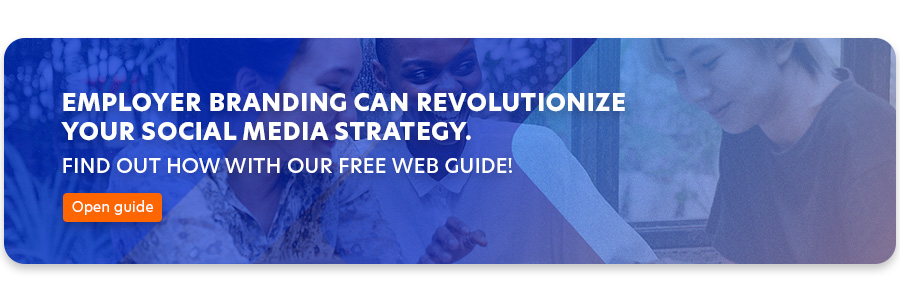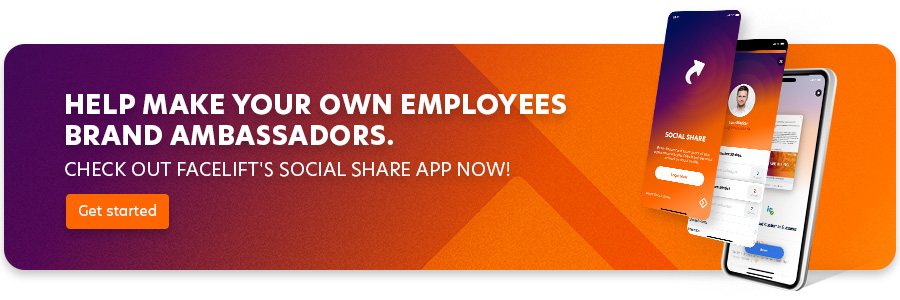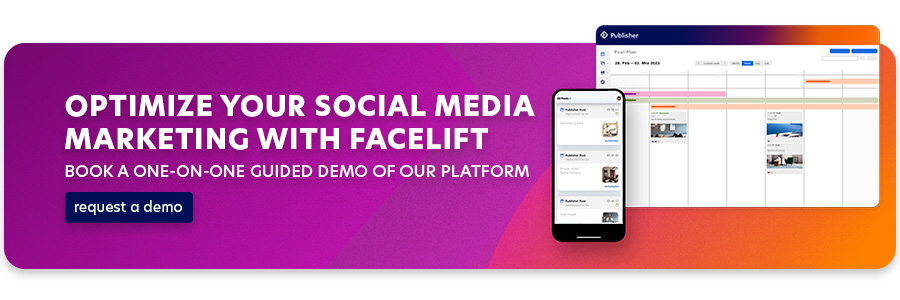Social media reach is anything but free. Companies cannot afford to ignore the power of employee advocacy. The loss of reach and missed opportunities are too significant to ignore. Surprisingly, however, many companies have yet to realize the full potential that lies within their employees.
98% of your employees are already on social media. This means you already have a solid base to present your company on social platforms.
And here's the big question: why leave this resource untapped?
In this article, we'll take a step-by-step look at how to develop and implement a successful employee advocacy program. We'll show you why engaging your employees in your company's goals is important and how to do it in a profitable way for both your company and your employees. It's time to harness the full potential of your teams on social platforms and achieve great things together.
What is employee advocacy?
Employee advocacy is, first and foremost, a program that is part of a company's communications strategy. Employee advocacy can happen online and offline because, at its core, employee advocacy is just employees speaking up for the company.
While word-of-mouth still has value today, social media is a new level of leverage in terms of reach. Employee advocacy on social media highlights a company's posts, ads, stories, or other publications by having employees share or repost the content on their personal social accounts. They take on the role of influencers in their immediate environment, increasing the company's visibility by multiplying its reach.
As an organization, you are very dependent on your employees' buy-in, as the program requires the use of personal social networks. The more motivated your employees are, the more positive effects will flow to you.
Benefits of employee advocacy
Employee advocacy has many benefits, so it's essential to incorporate it into your social media strategy.
Impact on your company culture
Your employees are trusted brand influencers. Encouraging them to post relevant, interesting content from the company can give them a sense of satisfaction and long-term fulfillment. They actively shape the brand and play a critical role in the communications strategy, regardless of hierarchical level or department. This strengthens your corporate culture.
This aspect of employee advocacy also helps strengthen employees' personal branding. They gain visibility among other professionals and can be perceived as experts in their field.
A recruiting advantage
What if your recruiting campaigns could reach a whole new set of candidates? Your employees draw attention to your brand and promote your activities. This is a great way to attract new talent to your team. Companies research potential candidates while recruiting and exploring the brand they are applying for. 95% of candidates research a company before they join it. Therefore, it is essential to strengthen your employer brand to attract the most desirable talent.
Employee advocacy, for example, allows you to highlight what your brand is doing to improve employee well-being and thus strengthen your employer brand. Of course, you can also directly ask your employees to share job openings.
Organic reach as a business advantage
One of the main arguments that C.E.O.s use against employee advocacy is that "this is not how we reach our target audience." And indeed, some companies have particular target groups that their employees hardly represent.
But as the saying goes? Birds of a feather flock together. That's why 70% of my LinkedIn connections are marketing professionals. It is very appropriate when we sell a marketing solution. However, my contacts include pharmacists, travel agents, engineers, and doctors.
However, the overall increase in content distribution can generate multiple business opportunities for the company. With employee advocacy: the brand uses an inbound marketing strategy to attract customers. Content shared on employees' social networks attracts potential customers who are more likely to trust the company based on what the employee says.
Even if an employee's best friend is not in the target audience, she will likely like the post, and the effect is multiplied. In numbers, this means an employee's participation in an employee advocacy program leads to seven times higher lead conversion than leads gained through direct acquisition. Companies can reach new audiences through increased organic reach by implementing an employee advocacy strategy.
Successfully implementing employee advocacy in 6 steps
Step 1: Start with an engaged culture
Suppose your employees don't love their jobs or the company. In that case, they won't be motivated to participate in the employee advocacy program - or the result will differ from the positive word-of-mouth you're hoping for.
Therefore, two things are essential for the starting point and, therefore, the success of the project:
- A positive relationship with the organization: Studies show that an engaged culture is based primarily on the following aspects: having a mission and a goal, knowing exactly what is expected, being provided with materials to do the job well, having someone who cares about their success and encourages their development, being able to express opinions. These are all aspects closely linked to your employees' positive work experience. And therefore, it is a real hygiene factor independent of employee advocacy.
- Strategic internal communication: You will need a lot of this, especially in the beginning, because you will need to ensure that your potential corporate influencers know about the posts, which they will then repost in the best-case scenario. This can be a real challenge, especially in corporate cultures where social media is not an integral part. LinkedIn has a great feature (the bell) that allows employees to opt in to be notified when there is new content.
Social Media Orchestration and Communication Orchestration are ways in which employees are enabled across teams and channels to work together. Employee advocacy and employer branding are core elements of Communication Orchestration, which you can read more about here in our
Communication Orchestration Manifesto.
Step 2: Set goals and KPIs for employee advocacy
We touched on this briefly above, but satisfaction also depends on expectations. So, before you ask employees to participate, it's essential to understand why you're asking them to join in the first place.
Examples of goals for your employee advocacy program might be:
- Generate 30% more leads
- Attract talent, e.g., 20% more applicants or reduce the application process by five days.
- Improve brand awareness (hard to measure, not hard to do!).
In addition, there are a few other KPIs to keep an eye on:
- Top influencers: Which individuals or teams are sharing the most? Which advocates are generating the most engagement?
- Engagement: Are links being clicked, comments being left, likes being generated, or content being shared? What is the level of engagement per social network?
- Shared organic reach:
How many people see the content your employees share? - Traffic: How much traffic did content shared by employee advocates drive to your website?
- Brand Sentiment: How did your advocacy campaign impact overall brand sentiment?
Step 3: Identify top employee advocates
Say goodbye to the idea that business leaders must also be project leaders because in the employee advocacy program, in particular, you should leave the technical leadership to the social media professionals. How do you identify them?
- Who is developing a personal social brand? Is someone already a social seller?
- Who is already sharing industry content on their behalf?
- Who is the public face of your company, whether by position (speaking engagements, PR, etc.) or number of social contacts?
- Who is passionate about the industry or your company?
Once you've identified these top influencers, let them help you build the employee advocacy program. Involve them in defining and communicating campaigns, setting goals, and creating incentives. They'll help you identify the tools and resources employees will most likely use and Share.
After all, they're already on the front lines! Trust their expertise. Then, work with your employee advocacy leaders to identify potential beta testers before rolling out your program company-wide. This will give you valuable feedback from less experienced colleagues. In our experience, there's usually much euphoria at the beginning of the program, and then it tapers off quickly. The reason is that there often needs to be more accountability internally.
Step 4: Create policies and engage people
Once everyone is on board, remember that not everyone is a professional from the start. They are uncertain and want answers to their questions. What language should I use? How often should I post? How do I respond to comments? To remove these uncertainties and empower them to act in your best interest, they need two documents:
- Social media content guidelines: a "do's and don'ts" for what employees should share, topics to avoid (e.g., politics, etc.), answers to frequently asked questions (FAQs), and more.
- Brand guidelines: These are the visual guidelines, including the use of the company logo, unique terms or spellings the company uses (e.g., it's called Facelift, not facelift or face lift!), hashtags to use (e.g., #successonsocial), and more.
These guidelines should provide direction, not police your employees. Put yourself in their shoes: the longer the list you ban, the more insecurity you create rather than eliminate.
Make sure the policy is easy to understand and follow. It shouldn't be a boring 50-page text document. Include visual examples and recommendations on how, where, and how much content should be shared.
Once you have goals and guidelines in place, it's time to reach out to your employees. Tell them about your advocacy program and tools, and get them started!
Step 5: Create content
The real key to getting your employees to share? Give them content that makes their jobs easier or positions them as industry experts. Research from LinkedIn shows that users who share content get 600 percent more profile views and grow their networks three times faster.
Of course, you can't force your employees to share content, so get them involved in creating it. Share your current social media strategy with them and ask them what types of content would showcase your company culture or align with the goals of your employee advocacy program. If they have specific content requests, such as sales wanting product announcements or HR wanting job postings, and you fulfill those requests, you'll have a loyal group of employee advocates.
Step 6: Extrinsic Motivation
Employees will only stay on the ball if you give them something in return. After all, you as a company benefit tremendously from their efforts. So, whenever you can, please remind your employees of their benefits: for example, they position themselves as industry experts, build a network, and have increased visibility (which, of course, increases their value).
But a tangible reward for their achievements is not, so you should combine it with more substantial things like gift cards or prizes.
Many brands use gamification for their employee advocacy program, making it a game or contest. For example, create a hashtag to promote a particular campaign. Then, create a leaderboard to see who gets the most impressions or engagement for the hashtag. Award the winner by giving away a prize or entering everyone who shares the campaign into a drawing to give everyone a fair shot. Other ideas include VIP programs, prospect development opportunities (in - or out of - the advocacy program), different batches, or even putting commission logic behind lead generation.
Employee advocacy tools make it even easier!
You can start implementing employee advocacy right now.
To be successful, it needs to be easy and practical to manage.
That's why we offer a dedicated employee advocacy management application.![]()
The Amplify app is the perfect tool to quickly and easily launch an employee advocacy program. The simple and intuitive interface allows employees to share company-generated content according to their preferences. They can also use interest groups to find the most relevant content with just a few clicks. They can also analyze the reach of published content and evaluate its appeal.
If you're already using Facelift to schedule your social media activities, adding Amplify is easy. But even if you don't, we can get you onboarded quickly. Today, You can learn how Amplify can increase your organic reach and lower costs in the long run. Don't wait any longer and request your free consultation! 👇👇👇









